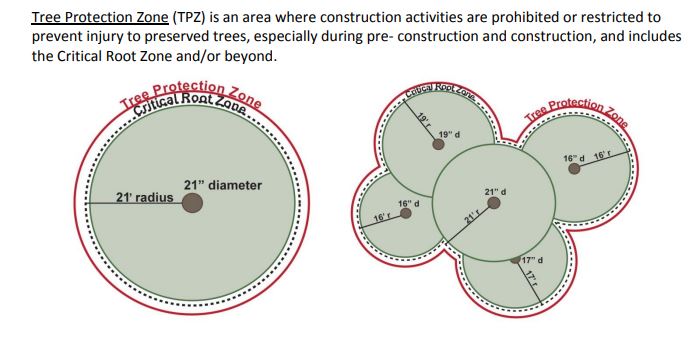Tree Protection Zone (TPZ) – Avoiding Tree Damage During Construction
Tree Protection Zone (TPZ) is an area where construction activities are prohibited or restricted to prevent injury to preserved trees, especially during pre- construction and construction, and includes the Critical Root Zone and/or beyond.
How Trees Are Damaged During Construction
Physical Injury to Trunk and Crown.
Construction equipment can injure the above-ground portion of a tree by breaking branches, tearing the bark, and wounding the trunk. These injuries are permanent and, if extensive, can be fatal.
Root Cutting.
Digging, grading, and trenching associated with construction and underground utility installation can be quite damaging to roots. A tree’s root system can extend horizontally a distance 1 to 3 times greater than the height of a tree. It is important to cut as far away from a tree as possible to prevent damage that can compromise tree health and stability. Cutting under a tree’s crown can reduce tree vitality. Cutting roots close to the trunk can severely damage a tree and limit its ability to stay upright in storms.
Soil Compaction.
An ideal soil for root growth and development contains about 50 percent pore space for water and air movement. Heavy construction equipment can compact soil and dramatically reduce pore space. Compaction inhibits root growth, limits water penetration, and decreases oxygen needed for root survival.
Smothering Roots by Adding Soil.
The majority of fine water-and-mineral-absorbing roots are in the upper 6 to 12 inches (15 to 30 cm) of soil where oxygen and moisture levels tend to be best suited for growth. Even a few inches of soil piled over the root system to change the grade can smother fine roots and eventually lead to larger root death.
Exposure to the Elements.
Trees in a forest grow as a community, protecting each other from the elements. The trees grow tall with long, straight trunks and high canopies. Removing neighboring trees during construction exposes the remaining trees to increased sunlight and wind which may lead to sunscald or breakage of limbs and stems.
Planning
Your arborist and builder should work together early in the planning phase of construction. Sometimes small changes in the placement or design of your house or driveway can make a great difference in whether a critical tree will survive. Alternative construction methods can be discussed, such as bridging over the roots as a substitute for a conventional walkway, if flexibility in placement is limited. If utilities cannot be re-routed away from trees, less damaging tunneling and trenching installation techniques exist.
Erecting Barriers
Treatment for construction damage is limited, so it is vital that trees be protected from injury. Set up sturdy fencing around each tree that is to remain, as far out from the tree trunk as possible to provide above- and below-ground protection. Place fence approximately one foot (0.3 m) from the trunk for each inch (2.5 cm) of trunk diameter.
Instruct construction personnel to keep fencing intact and the fenced area clear of building materials, waste, and excess soil. No digging, trenching, or other soil disturbance should be allowed in the fenced area.

Limiting Access
If possible, allow only one access route on and off the property. All contractors must be instructed where they are permitted to drive and park their vehicles. Often this same access drive can later serve as the route for utility wires, water lines, or the driveway.
Specify storage areas for equipment, soil, and construction materials. Limit areas for burning (if permitted), cement wash-out pits, and construction work zones. These areas should be located away from protected trees.

